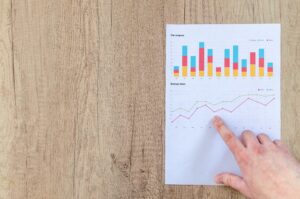Key Takeaways
- Gathering and Cleaning Sales Data
- Analyzing Sales Data for Insights
- Forecasting Sales
- Making Data-driven Decisions In Sales
Generate Data-driven Insight and Forecasts
In today’s ever-evolving digital landscape, leveraging data and analytics to create meaningful insights and accurate forecasts is key. Gaining insight into sales data is essential to staying ahead of the competition and making informed decisions. With the right analytic tools, you can generate powerful data-driven insights and forecasts that will help your business succeed. By leveraging the science of predictive analytics, companies can gain an advantage in their market by utilizing real-time insights into customer behavior, trends in their industry, and more. In this article, we’ll discuss how businesses can use data-driven insights and forecasting to make smarter decisions about their sales strategies.

Gathering and Cleaning Sales Data
Before a sales team can analyze its performance, it must have all the necessary data. This means gathering up-to-date sales records across all channels and then cleansing the data to ensure each record is accurate and complete. Collecting sales data helps identify trends, measure performance, prioritize initiatives, and more. Cleaning the sales data helps to eliminate any errors in reporting or other discrepancies that can otherwise interfere with the team’s understanding of their performance.
So what’s the importance of accurate data? Every sales meeting and every strategy is based on a set of reliable, consistent data points. Without accurate information, sales teams are unable to make decisions. Analyzing data and optimizing performance is the key to success in any sales organization. Accurate data can help the team identify customer behavior patterns, track progress toward sales goals and make better decisions based on data-driven insights.
Methods for Cleaning Sales Data
There are several methods sales teams can use to clean their data to ensure accuracy.
- Automation: Automation tools can speed up the data-gathering process and help minimize errors. Automated systems pull in sales figures from multiple sources, allowing teams to quickly and accurately compile real-time sales data.
- Database Checks: Cleaning sales data requires teams to check the validity of each record. This includes double-checking the accuracy of customer information, verifying pricing structures, validating order details, and more. The goal is to ensure that each record is up-to-date and accurate.
Identify the Different Types of Data Sources Available for Insights
Before delving into data analytics, it’s essential to identify the different types of data sources available for gathering insights. Broadly, these can be divided into two categories: structured and unstructured data. Structured data is tidy, organized, and follows a rigid structure such as a database table; it often includes fields and values such as names and addresses. Unstructured data is more raw, chaotic, and often unorganized; it can include text documents, images, audio and video files, emails, etc.
Both types of data sources provide valuable insights – the key is to leverage the right tool for the job. Structured data can be used to uncover trends and correlations, while unstructured data can help to identify valuable customer feedback or understand user preferences. With the right data sources, meaningful insights can be gained to help inform decisions and drive success. And with advanced analytics, these insights can be transformed into meaningful and actionable results.
The right combination of structured and unstructured data sources can help provide a comprehensive picture of an organization’s performance and identify opportunities for improvement. Data analytics can then optimize processes, refine user experiences, and develop better products and services, which helps drive business success.

Analyzing Sales Data for Insights
Once you have collected your sales data, the next step is to analyze it for insights. When uncovering valuable insights, you need to look at the larger picture and recognize patterns within your data. Data analytics is a powerful tool that can help you identify hidden trends, uncover sources of sales lift, and build a more accurate picture of your company’s performance. Gartner argues that data analytics is essential to delivering exceptional customer experiences and driving business success.”
Through data analysis, you can gain insights into customer behavior, product performance, and overall business performance. Analyzing sales data aims to discover patterns and correlations and understand customer behavior. When done correctly, analyzing sales data for insights can help you identify key opportunities to drive growth, improve efficiency, and make better decisions.
You can use several methods of analysis when working with sales data. These include:
- Descriptive analysis: This is a powerful method of analyzing sales data for insights. It involves collecting and examining qualitative and quantitative information to identify patterns, relationships, and trends. It enables data analysts to make data based decisions, as it focuses on describing the characteristics and behavior of a particular dataset. By understanding the underlying patterns, descriptive analysis helps data analysts better understand customer behavior and develop strategies for optimizing sales performance.
- Predictive analysis: This is a prediction-based method of analyzing sales data for insights that enable businesses to be proactive and strategic in their decision-making. Predictive analysis allows companies to identify potential opportunities and risks, create forecasts and models to understand customer needs better, and anticipate future events. It uses data collected from past and current trends to predict what could happen in the future.
- Segmentation analysis: As a method of analyzing sales data for insights, segmentation analysis is an invaluable tool. This technique involves grouping individual customers into distinct categories based on shared characteristics such as spending habits, customer preferences, and demographics.
- Regression analysis: The most sophisticated and advanced method of analyzing sales data for insights is regression analysis. This technique involves building a statistical model to identify relationships between different variables. Through regression analysis, data analysts can develop an understanding of customer behavior and identify important trends. It helps businesses understand which factors affect customer buying habits and better anticipate future trends. This ultimately helps businesses optimize their strategies and maximize sales opportunities.
Visualization Techniques for Sales Data
Once you have analyzed your sales data for insights, the next step is to visualize it. Visualization techniques are important in helping businesses make sense of their data and produce real-time insights. When done correctly, visualization techniques can help you quickly identify trends and unlock potential sources of growth.

Some of the benefits of visualizing sales data include the following:
- Improving data understanding: Data visualization techniques can help businesses quickly comprehend and interpret large amounts of data. By using visuals such as charts, graphs, and maps, businesses can better understand their data and uncover key insights.
- Identifying patterns: Visualization techniques provide a more comprehensive view of data. By creating visuals, businesses can easily identify patterns and relationships within their data that are otherwise hidden in a table format.
- Communicating complex ideas: Visuals are also a powerful tool for communicating complex ideas. By using visuals, businesses can present their data in a more accessible and engaging way, making it easier to communicate findings to stakeholders.
- Revealing actionable insights: When data is visualized correctly, it can reveal actionable insights that can help businesses identify potential areas for growth and drive decisions.
Common visualization techniques that you can use when working with sales data include:
- Bar/column graphs: These are one of the most common visualization techniques used in sales analysis. Bar and column graphs allow businesses to compare different categories of data side-by-side. Businesses can identify patterns, measure performance trends, and compare different groups through bar and column charts.
- Pie charts: Pie charts are useful for visualizing sales data in a simplified format. This type of chart allows businesses to see the percentage of each category’s total sales. Pie charts are especially helpful for identifying which product categories are selling well and which ones need improvement.
- Line graphs: Line graphs depict the overall trend over time and allow businesses to visualize changes in sales performance. Businesses can identify seasonality and compare performance over different periods through line graphs. These visuals are useful for identifying opportunities to increase sales and make improvements.
- Heat maps: Heat maps are a powerful visual tool for understanding customer buying patterns and product performance. They provide an overview of sales performance across different regions or demographics, enabling businesses to identify areas of strength and weakness.

Forecasting Sales
Forecasting sales is an essential business strategy that leverages data to inform decisions and enable businesses to capitalize on opportunities, anticipate and mitigate risks, and maximize profits. Forecasting sales require collecting internal data such as past transactions, customer segmentation and preferences, market trends, and external data such as competitive analysis and economic indicators.
Companies can accurately anticipate customer behaviors and predict future sales performance by utilizing predictive analytics to interpret the available data. This allows businesses to position themselves strategically and helps them develop tailored marketing campaigns and optimize operational efficiency. With effective forecasting, businesses can drive higher revenues and make well-informed decisions about the growth of their organization.
Importance Of Forecasting In Sales
Forecasting in sales plays a critical role in enabling businesses to plan for their future success. Not only does forecasting allow organizations to understand the demand for their products and services, but it also assists in setting targets that can be used to guide a company’s strategic objectives.
The following are just a few of the key benefits of forecasting in sales:
- Predicting potential customer demands and trends: The study of consumer behavior is key to predicting potential customer demands and trends. As market conditions fluctuate, forecasting such demands and trends is essential for sales teams to ensure that the right products are available at the right time. Businesses must develop strategies for collecting data about customer demographics, preferences, and buying habits to accurately anticipate what customers will look for. This helps organizations deploy resources efficiently and be ready to satisfy customer needs as they emerge.
- Better managing resources: With limited resources as a reality for many businesses, ensuring that resources are used to their fullest potential is essential for success. Using forecasting to anticipate opportunities and demands helps guide resource allocation. Forecasting helps inform business decisions on when and where to purchase resources, how much inventory to keep on hand, and when to increase staff for peak demand.
- Estimating growth potential: Every business must know what its potential growth looks like to plan for the future. Without a clear understanding of how much revenue could potentially be generated, it is difficult to determine how much should be spent on marketing, advertising, and other resources.
Metrics Used In Sales Forecasting
The metrics used in sales forecasting are important to consider when planning and budgeting for future sales activity. They provide a snapshot of what is likely to happen in the future and allow for more accurate projections that can be used to make better strategic decisions. Commonly used metrics include:
- Quota: A quota is the estimated amount of sales that an individual or team must achieve to meet their goals. Quota is an important sales forecasting metric as it helps set expectations, motivate team members, and measure progress toward goals. It can also provide insights into expected customer behavior, competitive performance, and market trends.
- Sales cycle: A sales cycle is a metric used to measure the time it takes for a customer to move through various stages of the buying process. It is a valuable tool for sales forecasting as it reveals areas where sales processes can be improved, and it can help identify patterns in customer needs and preferences. The sales cycle begins with a lead generation stage where potential customers are identified and nurtured until they are ready to move further into the process.
- Sales pipeline: As a metric that tracks the progress of sales opportunities, a sales pipeline offers an overview of prospects throughout their respective buying cycles. It is typically organized by stages and helps sales teams better understand the probability of a sale being closed.
- Historical sales patterns: For sales forecasting, historical sales patterns have been used for years to make well-informed decisions about future sales. Historical data can provide insight into potential trends, market movements, and other fluctuations that can be used to make more accurate forecasts.
- Cohort analysis: This is an analytical metric used to identify patterns of behavior among customers and track them over time. This powerful technique sheds light on customer retention rate, purchase behavior, and the effectiveness of marketing strategies. Cohort Analysis can help companies better understand their customers’ needs, enabling them to develop more successful products and services and make more informed decisions.
Making Data-driven Decisions In Sales
Data-driven decision-making in sales is a powerful tool for achieving optimal outcomes. It leverages the power of big data to identify trends, connect with customers, better understand market dynamics, and accurately forecast results. With shrinking budgets and increasing time pressures, managers and sales teams can no longer rely on intuition alone. Instead, they must use data to inform their decisions and execute their strategies.
For example, sales teams can use data to identify the characteristics of their ideal customer profile. They can use this knowledge to target new leads and better understand how to engage existing customers. They can also use data to predict customer behavior and forecast sales results. It is, therefore, essential for companies to invest in data-driven decision-making tools to fully leverage their data.
Conclusion
Reaching sales milestones and optimizing team outcomes don’t have to be an uphill battle. At SFE Partners, we believe success is found in the details, driving impactful transformation through data-driven insights. Our technological platform ensures informed forecasts and streamlines sales processes, giving you the forecasting accuracy your teams need to make strategic decisions. We offer complete end-to-end solutions that get results so you can launch or scale quickly, squashing any roadblocks. It’s time for informed decisions that create positive change for your organization. Join us as we discover what data-driven insight can do for you. Uncover the potential when sharp vision meets meaningful action: learn more with SFE Partners today.




